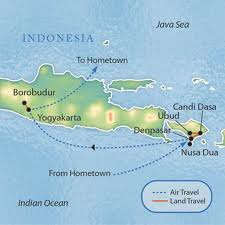Borobudur is located nearby area between two volcanoes of Sundoro-Sumbing and two others of Merbabu-Merapi, and also two rivers, the Progo and the Elo. It is about 40 kilometres northwest of Yogyakarta and 86 kilometres west of Surakarta, more precisely it is in Magelang, Central Java, Indonesia. Because of its high soil fertility this place has been called “the garden of Java” and according to local myth this area which known as Kedu Plain described as Javanese sacred place.
In Indonesian, ancient temples are referred to as candi; therefor local people refer to "Borobudur Temple" as Candi Borobudur.
It is a 9th-century Buddhist monument. Decorated with 2,672 relief panels and 504 Buddha statues this monument has six square platforms topped by three circular platforms.
It was built during the reign of the Sailendra Dynasty. India's influence on the region reflects on the temple’s design in Gupta architecture, but still there are some scenes and elements that make Borobudur uniquely Indonesian. The monument is a shrine to the Lord Buddha as well as a pilgrimage place for Buddha follower.
For centuries under layers of volcanic ash and jungle growth Borobudur lay hidden. The reasons why it had been abandoned , remain a mystery.
From 1811 to 1816 Java was under British administration. Thomas Stamford Raffles was elected as Governor-General. He took great interest in the history of Java and collected Javanese antiques. He made notes during his journey throughout the island through contacts with local inhabitants. On one occasion when he went to Semarang in 1814 to conduct certain inspection duty, he was informed about a big monument near Bumisegoro village deep in a jungle. He himself couldn’t make the discovery and asked a Dutch engineer, H.C. Cornelius, to do some investigation. For as long as two months, Cornelius and his 200 men cleaned the area and dug away the earth to find the monument. Afraid of being collapse, he was not able to reveal all galleries.Since then Raffles has been credited with the monument's recovery and had brought it to the world's attention


No comments:
Post a Comment